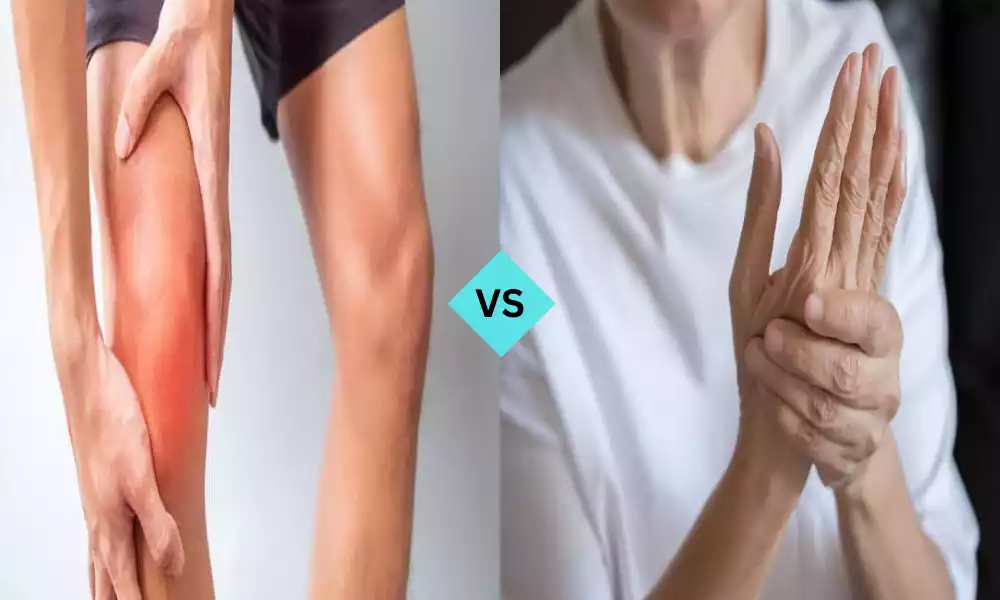Introduction
Knee pain is a common complaint amongst many individuals, regardless of age or activity level. Understanding the source of this pain is essential for appropriate treatment. Two frequent causes of knee pain include Patellofemoral Pain Syndrome and Osteoarthritis. Although both involve the knee joint, their causes, symptoms, and treatments differ significantly. This article dives deep into the differences between these two conditions, helping medical professionals, patients, and caregivers better understand them.
Patellofemoral Pain Syndrome
Patellofemoral Pain Syndrome (PFPS) is a condition characterized by pain in the front of the knee, around the patella (kneecap). Often referred to as “runner’s knee,” it’s commonly associated with athletes and activities involving repetitive knee movements. The pain arises due to improper tracking or alignment of the patella in its groove on the femur, leading to irritation of surrounding tissues. Typical symptoms include a dull, aching pain, especially during activities like climbing stairs, squatting, or running. Management often involves rest, physical therapy, and addressing underlying biomechanical issues.

Causes
- Patellofemoral Pain Syndrome:
-
- Overuse due to repetitive motion, such as running or jumping.
- Malalignment of the patella.
- Muscle imbalances or weaknesses, particularly in the quadriceps.
- Flat feet or other foot abnormalities.
Symptoms
- Patellofemoral Pain Syndrome:
-
- Pain in the front of the knee, aggravated by sitting for long periods, squatting, or walking up and down stairs.
- Occasional knee buckling, where the knee suddenly gives out.
- Grinding or clicking sensation in the knee.
Osteoarthritis
Osteoarthritis (OA) is a degenerative joint disease characterized by the breakdown of joint cartilage and the underlying bone. Often referred to as “wear and tear” arthritis, it’s the most common form of arthritis and typically affects older individuals. OA can lead to pain, stiffness, reduced joint flexibility, and swelling. Although it can affect any joint, it commonly involves the knees, hips, hands, and spine. Factors like aging, obesity, genetics, and joint injuries can increase the risk of developing OA. Management includes pain relief measures, physical therapy, weight management, and in advanced cases, surgical interventions.

Causes
- Osteoarthritis:
-
- Aging, as the cartilage wears down over time.
- Genetics, with some individuals being predisposed.
- Injuries to the joint, such as fractures or ligament tears.
- Obesity, putting extra strain on the knee joints.
- Other diseases, like rheumatoid arthritis.
Symptoms
- Osteoarthritis:
-
- Persistent joint pain and stiffness.
- Swelling in one or more joints.
- A decreased range of motion.
- A grating sensation or crunching feeling when using the joint.
Comparison Table of Patellofemoral pain syndrome and Osteoarthritis
Below is the comparison table of patellofemoral pain syndrome and Osteoarthritis:
| Feature/Aspect | Patellofemoral Pain Syndrome (PFPS) | Osteoarthritis (OA) |
|---|---|---|
| Origin/Etiology | – Often due to improper kneecap alignment or overuse.
– Overuse injuries. |
– Degenerative joint disease.
– Age, obesity, joint injury, and genetics are factors. |
| Clinical Presentation | – Dull, aching pain in the front of the knee.
– Pain aggravated by activities like squatting, climbing stairs, or prolonged sitting. |
– Joint pain, stiffness, reduced range of motion.
– Symptoms worsen over time. |
| Age Group Affected | – Younger population, especially athletes. | – Older adults primarily, but can start earlier with predisposing factors. |
| Pathology | – Mainly a soft tissue issue.
– No actual joint damage. |
– Wear and tear of cartilage.
– Leads to bone rubbing on bone. |
| Imaging | – Might show malalignment or tilt of the patella.
– Often normal X-rays. |
– Reduced joint space, bone spurs, sometimes cysts.
– Weight management, physical therapy. |
| Treatment | – Physical therapy.
– NSAIDs. – Orthotics, patellar taping. |
– Pain relievers, anti-inflammatory medications.
– Intra-articular injections, surgery in advanced cases. |
| Impact on Global Health | – Can limit physical activity in young adults.
– Reduces quality of life if not managed. |
– Among top 10 disability-causing diseases globally.
– Huge financial burden due to treatments & work loss. |
| Prevention | – Proper training for athletes.
– Avoiding repetitive knee stress. – Correct footwear. |
– Weight management, regular exercise.
– Avoiding joint injuries. |
This table provides a concise overview of the key differences between PFPS and OA. Further detailed studies and consultation with medical professionals are recommended for a comprehensive understanding.
Similarities Patellofemoral Pain Syndrome and Osteoarthritis
Both Patellofemoral Pain Syndrome (PFPS) and Osteoarthritis (OA) are conditions associated with the knees and can result in pain and functional impairment. Here are the similarities between the two:
- Pain Location: Both conditions often manifest with knee pain, which may become more prominent with specific movements or after prolonged periods of inactivity.
- Aggravation by Activity: Activities such as squatting, kneeling, or climbing stairs can exacerbate pain in both PFPS and OA.
- Stiffness: Both conditions can be accompanied by knee stiffness, especially after long periods of sitting or upon waking in the morning.
- Audible Crepitus: Both PFPS and OA can be associated with a grinding or crunching sensation (crepitus) in the knee joint during movement.
- Swelling: Both conditions can lead to intermittent swelling of the knee joint.
- Functional Impairment: Both PFPS and OA can lead to difficulty in performing daily activities, especially those that require knee flexion or weight-bearing.
- Conservative Treatment: First-line treatment for both PFPS and OA often involves conservative measures such as physical therapy, pain management with NSAIDs (Non-Steroidal Anti-Inflammatory Drugs), and lifestyle modifications.
- Benefit from Weight Management: Being overweight or obese can exacerbate the symptoms of both conditions. Weight loss or maintaining a healthy weight can alleviate symptoms and reduce the progression of the disease in OA and decrease the pain severity in PFPS.
- Exercise as a Management Tool: Supervised and tailored exercise regimes can be beneficial for both conditions. Strengthening the muscles around the knee can provide better support and function, whether dealing with PFPS or OA.
- Limitation in Activities: Due to pain and discomfort, individuals with either PFPS or OA may have to limit certain activities or sports to prevent exacerbation of their symptoms.
- Joint Protection: Both conditions benefit from measures that protect the knee joint from excessive wear and tear. This might include using knee braces, orthotics, or avoiding high-impact activities.
- Patient Education: An essential aspect of managing both PFPS and OA is patient education. Understanding the condition, its prognosis, treatment options, and self-management techniques can significantly improve outcomes.
While PFPS and OA have these similarities, it’s essential to recognize their distinct etiologies, presentations, and long-term prognoses. Proper differentiation between the two is crucial for accurate diagnosis and treatment.
Diagnosis Methods
- Patellofemoral Pain Syndrome:
-
- Physical examination focusing on the knee joint, alignment, and range of motion.
- Imaging tests such as X-rays or MRI might be used to rule out other conditions.
- Osteoarthritis:
-
- Clinical history and examination, focusing on joint tenderness, swelling, and stiffness.
- X-rays to identify joint damage and cartilage loss.
- Blood tests and joint fluid analysis to rule out other types of arthritis.
Understanding the distinct differences between Patellofemoral Pain Syndrome and Osteoarthritis is crucial for accurate diagnosis and effective treatment. Proper knowledge of these conditions empowers patients to seek appropriate care and interventions.
Treatment Approaches

Patellofemoral Pain Syndrome (PFPS):
- Conservative Management: Physiotherapy focusing on quadriceps strengthening is pivotal. Emphasis on the vastus medialis obliquus (VMO) is beneficial.
- Medication: Over-the-counter pain relievers, like NSAIDs, can be effective.
- Orthotics: Shoe inserts can help align and stabilize the foot and ankle, reducing stress on the knee.
- Taping: Patellar taping can help align the kneecap and reduce pain.
Osteoarthritis (OA):
- Conservative Management: Weight management and physical therapy are cornerstone approaches.
- Medication: Pain relievers and anti-inflammatory medications can be prescribed. Intra-articular steroid injections are also used.
- Surgery: In advanced cases, joint replacement surgery might be recommended.
The Impact on Global Health
Patellofemoral pain syndrome:
- Common in young adults, especially those active in sports.
- It can limit physical activity, impacting overall health and wellness.
- Though not life-threatening, it can reduce the quality of life if not managed.
Osteoarthritis:
- OA is among the top 10 disability-causing diseases globally.
- It is estimated that 10-15% of all adults aged over 60 have some degree of OA.
- The financial burden due to OA-related treatments and loss of work is tremendous.
Coping of Patellofemoral Pain Syndrome and Osteoarthritis
Patellofemoral pain syndrome:
- Proper training and conditioning for athletes.
- Avoiding repetitive stress on the knees.
- Using correct footwear.
Osteoarthritis:
- Weight management to reduce stress on joints.
- Regular exercise to maintain joint health.
- Avoiding joint injuries.
Conclusion
While both Patellofemoral Pain Syndrome and Osteoarthritis present with knee pain, their clinical presentation, management, and impact on global health vary significantly. Early and accurate diagnosis is crucial to ensure appropriate treatment and improve outcomes.



